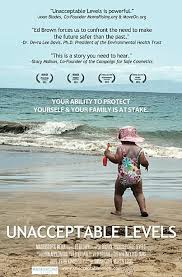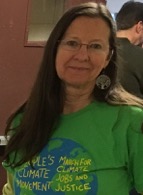
Our planet is drowning in synthetic chemicals. Our bodies have become synthetic chemical processing plants. A 2005 Environmental Working Group study of umbilical cord blood revealed that babies are born already pre-polluted with over 200 industrial contaminates. Hundreds of the more than 80,000 pervasive, toxic, man-made concoctions make their way into our bodies every day, but only a handful have been tested for safety. Our government thinks this is an “acceptable level of risk.” Innovations from World War II, chemistry originally designed to kill for warfare, were unleashed after the war to meet the public’s ever-increasing demands for consumer conveniences to fill busy, prosperous lifestyles. The material basis of our society is built on fossil fuel feedstocks. 90% of man-made chemicals come from oil, coal, and gas. Hydrocarbons are plentiful and easy to work with. We eat, drink, breathe, wear, touch, and slather our bodies with petrochemicals every day. “We live in a sea of chemicals.”
In February, the Sierra Club and Peoples Climate Movement, with other local organizations, screened the film Unacceptable Levels at the Unitarian-Universalist Church of Urbana-Champaign. In 2009, the smell of chlorine in a glass of water led an everyday guy named Ed Brown to start asking serious questions about how polluted the world around him and his family just might be. Over two years, Brown asked a lot of questions and traveled thousands of miles. He spoke with experts, authors, doctors, scientists, CEOs, and environmental advocates who helped open his eyes to the magnitude of this unrealized threat to our collective health. (Industry reps and government officials refused his invitations to speak with him.) He shares this journey with us in his film because he feels that “we are all in this together.”
And what he finds is disturbing. Our bodies and nature are taking a beating from the endless proliferation of synthetic chemicals, the lack of government regulation and oversight, and industry’s power over our elected officials. We are never exposed to just one chemical at a time, but to combinations of many in all the products we use and eat. Although the amount of each of these chemicals may be tiny, we are learning that it is the combination and constant exposure that threatens our well-being. Science is telling us these chemicals get into our bodies and act like drugs in ways that were never intended and over which we have no control. And worse, we have no understanding of how we are passing these chemicals on to our children. Direct correlation between exposure and illness is not always possible, and is often impossible. We are exposed over our lifetimes to a legacy of toxic chemicals and pollutants (DDT, PCB, and PFOA, to mention a few) that persist in our environment indefinitely. What we do know is that we are becoming sicker, with more chronic illnesses, more cancers at younger ages and more rare cancers, more bizarre conditions and afflictions, even mental health problems. Autism is rising in alarming numbers. For the first time, most children in the U.S will have a chronic disease sometime during childhood. It cannot be bad genes. And lack of proof of harm is not evidence of safety. How can we treat cancers and other illnesses if we do not understand and deal with the causes?
A trip to Hawaii with his family brought Brown face-to-face with his inner self: 70% of the planet and 70% of humans is water. Water is the life support system of the planet. Everything we dump on our lands, blow into the air, and release into our waters ends up in our drinking water and our bodies. Pollution has spread to even the most remote waters we once thought pristine. Our throwaway lifestyle has created millions of tons of plastics that pollute our groundwater, wash up on our shorelines, and swirl around in ocean currents to create massive garbage patches hundreds of miles wide, and thousands of miles out of sight and out of mind. We have treated our waters with such disrespect.
Fluoridation of our public water systems for fighting cavities has a long and twisted story. The policy to add fluoride to our drinking water began in 1945 with the massive release of hydrogen fluoride from the DuPont Deepwater chemical plant in New Jersey that was processing uranium for the Manhattan Project nuclear weapons program. To protect defense contractors and the war effort from public outrage that could have led to lawsuits, government and industry whitewashed the true dangers of fluoride and forced fluoridation on an unsuspecting and trusting public. The fluoride in our water is not pharmaceutical grade, as we are led to believe, but waste from the phosphate fertilizer industry. Releasing this toxic byproduct into the air or waterways would be a pollutant, but by selling it to municipalities and bleeding it into their water systems it magically becomes a miracle cure.
More magic? Ever heard of sewer sludge? Human waste, pathogens, bacteria, viruses, industrial and medical waste, pesticides, household cleaning products, heavy metals, PCBs, flame-retardants, and thousands of other chemicals that are settled out of our local wastewater treatment plants create mountains of sewage sludge. In 1972 the Clean Water Act made it illegal to dump these individual contaminates directly into our lakes, rivers and oceans. By 1987 it was decided that the sludge itself was too toxic to dump into the sea or into landfills, or to incinerate. 1993 brought the Sludge Rule, claiming, through “sludge magic,” that this nasty mix was no longer toxic and could be applied to forests, parks, farms, public lands, and school playgrounds, and packaged for home gardeners. Nutrient-rich biosolids were invented! As we worry about our food supply and the depletion of our soils, millions of tons of this toxic sludge has been applied to lands across America for years. And we wonder why we are so sick, our food less nutritious, and ecosystems are contaminated.
Brown also turns his camera to genetically engineered crops and subsidized commodity agriculture, pesticides and other agricultural biocides, personal care products, sunscreens, food additives, colorings made from coal, and the Toxic Substances Control Act. Here is one not in his film: cash register receipts covered in bisphenol A, or BPA. Those unrecyclable strips of paper, handed to us with our change, go into our wallets or our pockets, rubbing off onto our hands, onto money, leaving traces of BPA that permeates our skin and gets into our bodies. We have been told to avoid plastics made of BPA, but its substitutes BPS and BPF are just as toxic. Not only are we cutting down virgin forests for the paper but now we cover that paper with cancer-causing chemicals. Illinois HB2076, which ban BPA and mandate that an alternative chemical be found—hopefully not one made of endocrine-disrupting hydrocarbons—is working its way through the legislature this year.
Ed Brown hopes that by bringing us along on his journey we feel empowered to make some decisions and changes in our own lives, to question what we are told, to make better choices by reading labels, and to believe that we are all capable of speaking out to our elected officials and to companies, and becoming advocates for ourselves, our loved ones, and our planet. It may seem an overwhelming task, but it is better to light one candle than to sit back and curse the darkness.
Lois Kain lives in Urbana, is a member of Food and Water Watch and Sierra Club, and welcomes all manner of birds, bees, and bugs into her chemical-free gardens.

